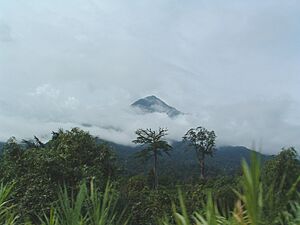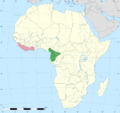Grey-necked rockfowl facts for kids
Quick facts for kids Grey-necked rockfowl |
|
|---|---|
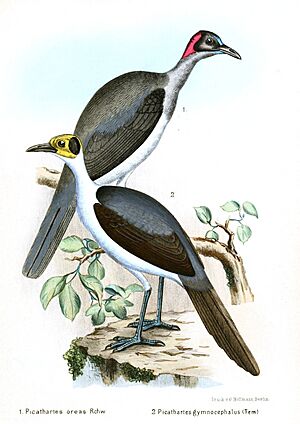 |
|
| Illustration grey-necked (background) with white-necked (foreground) rockfowl | |
| Conservation status | |
| Scientific classification | |
| Genus: |
Picathartes
|
| Species: |
oreas
|
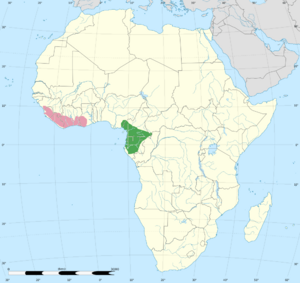 |
|
| The distribution of the grey-necked rockfowl (green) | |
The grey-necked rockfowl (Picathartes oreas) is a unique medium-sized bird found in the rainforests of West Africa. It has a long neck and tail. People also call it the grey-necked picathartes. This bird mainly lives in rocky areas of thick rainforests. You can find it from Nigeria through Cameroon, Equatorial Guinea, and Gabon. It also lives on the island of Bioko.
These birds often live near streams and rocky hills called inselbergs. The grey-necked rockfowl has grey feathers on its back. Its chest is light grey, and its belly is lemon-colored. Its head has almost no feathers. The skin on its forehead is powder blue. The back of its head is a bright red color. A large black patch covers its cheeks and eyes. This patch connects the blue and red skin on its head. Its long tail helps it balance.
Rockfowls mostly eat insects. But they also munch on some plants, like fruits and flower buds. They often follow swarms of army ants. They eat the insects that the ants scare out of hiding. These birds move through the forest by hopping and jumping. They also take short flights close to the ground. They usually travel alone or in small groups.
Grey-necked rockfowls are monogamous, meaning they have one mate. They build their nests from mud. These nests are shaped like deep cups. They are built on rock surfaces, often in caves or on cliffs. A pair usually lays two eggs twice a year. Even though they nest in groups, rockfowls sometimes try to harm the young of other pairs. Baby birds grow up in about a month.
This species is considered vulnerable. This means its numbers are going down. Their homes are being destroyed. People are working to protect these special birds. Some local people in Cameroon respect or even fear this bird. Today, many birdwatchers want to see this rockfowl. It has become a symbol for ecotourism in its home region.
Contents
About the Grey-necked Rockfowl
What is a Rockfowl?
The grey-necked rockfowl was first described in 1899. It was found near Mount Cameroon. Its scientific name is Picathartes oreas. The name Picathartes combines "magpie" and "vulture". The name oreas means "mountain" in Ancient Greek.
For a long time, scientists weren't sure where this bird fit in the bird family tree. It was placed in many different bird families. But today, the grey-necked rockfowl and its close relative, the white-necked rockfowl, are in their own special family called Picathartidae. Scientists now think this family is very old. DNA studies show they split from their relatives about 44 million years ago. Their closest relatives are the rockjumpers from southern Africa and the rail-babbler from Southeast Asia.
This bird has many common names. These include grey-necked picathartes, bare-headed rockfowl, and bald crow. "Rockfowl" refers to how it builds nests on rocks. "Bald crow" describes its featherless head and crow-like beak.
How Does It Look?
The grey-necked rockfowl is about 33 to 38 centimeters (13 to 15 inches) long. Its very long tail makes up about 14 centimeters (5.5 inches) of its length. Males and females look the same.
Its head has almost no feathers. The skin on its forehead and upper beak is powder blue. The rest of its beak is black and looks like a crow's beak. Small, stiff feathers on its head can stand up. The skin on the back of its head and neck is bright red. The areas around its eyes and cheeks are black and featherless. Its eyes are dark brown.
The bird's back, rump, and tail are grey. The feathers on its rump are long and soft. Its chin, throat, and upper chest are pale grey. Its lower chest, belly, and thighs are a buffy lemon color. Its wings are grey, but the main flight feathers are black. Its legs and feet are silver-grey and strong. An adult rockfowl weighs about 200 to 250 grams (7 to 9 ounces).
When a baby rockfowl hatches, it has almost no feathers. Its skin is dark pink with some black patches. As it grows, it starts to look like an adult. But its bare head skin is black or dark brown, not blue or red. Young birds have a golden yellow patch on the back of their head. Their tail is also much shorter than an adult's.
This rockfowl is usually quiet. It sometimes makes a soft, hissing "wheet" sound. When adults bring food to their nests, they make soft "peep" sounds. At the nest, they make a low "ga-a-a" sound, like a snore or sigh. They also make a "shisss" sound.
Where Do They Live?
The grey-necked rockfowl lives in West Africa. You can find it from southeastern Nigeria to southwestern Gabon. It is common in southwestern Cameroon, which is its main home. It also lives in Equatorial Guinea and on the island of Bioko. Its total home range is about 314,000 square kilometers (121,000 square miles).
These birds like rough areas in forests. They prefer places with large rocks, caves, and deep valleys. They are often found near rocky hills called inselbergs. They also need a water source nearby, like a river or forest pool. The forest floor where they live often has few plants. But it is covered in mosses, ferns, and climbing plants called lianas.
Rockfowls usually live between 450 and 2100 meters (1,476 and 6,890 feet) above sea level. They do not migrate. They stay close to their nesting sites all year. They can even live near people. Some nests have been found close to farms. This shows they might be more tolerant of human activity than once thought.
Life and Behavior
Rockfowls usually live alone or in pairs. But small groups of three to ten birds are also seen. They move by running and hopping on the ground or low branches. They use their long tail to keep balance. When in a group, they hop almost at the same time. When they do fly, they are fast and good at moving through trees and rocks.
When standing still, a rockfowl holds its tail down and looks up. They usually try to hide silently if they see something unusual. But if they know they have been seen, they can become curious. They might even come closer to watch people. They are not shy once they know you're there. They often study interesting things from an open spot. If they feel suspicious, they raise the small feathers on their head and neck. They also make a muffled groan.
They are most active in the early morning and late evening. From mid-morning to late evening, they usually rest. They perch in areas with many climbing plants or in caves away from their nests. To scratch their head, they lift their foot over their head. They also bathe in small pools. We don't know how long they live in the wild. But one lived for 25 years in a zoo.
What Do They Eat?
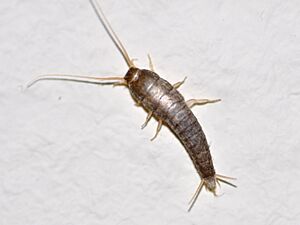
This bird looks for food in the early morning or late afternoon. It forages alone or in small groups. They search in leaf litter and on dead tree trunks. They also jump up to grab prey from hanging leaves. They find food by standing still and looking around. Or they toss leaves aside with their beak.
They often follow columns of Dorylus ants. They eat the insects that the ants disturb. They also hunt in streams for crabs and fish. They crush snails with their beak. If prey struggles, they smash it against the ground. Sometimes, male rockfowls have been seen giving food to females.
The grey-necked rockfowl eats many different insects and small animals. They also eat some plants. Their diet includes beetles, butterflies, ants, grasshoppers, cockroaches, earwigs, caterpillars, and earthworms. They also eat small lizards, frogs, snails, and slugs. Crabs, fruits, flower buds, mosses, and leaves are also part of their diet. Fish have been found in their diet in Nigeria. At some nesting sites, they eat insects that feed on bat droppings in caves. They also spit out undigested food in pellet form. About 52 to 60 percent of their diet is animals.
Reproduction and Life Cycle
The grey-necked rockfowl nests alone or in small groups. These groups usually have two to five nests. But one site had almost fifty nests. They are monogamous, meaning they only breed with their mate. In some areas, it seems they help each other raise young. For example, four birds were seen feeding one nest.
The eggs in a colony do not all hatch at the same time. This might encourage cooperative breeding. The time they lay eggs changes by region. It usually happens a few weeks before the rainy season starts. In places with two rainy seasons, they have two breeding seasons. In mountains, they breed during the dry season to avoid mist.
This rockfowl builds its nest on the sides of rocks. These are usually in caves or on steep cliffs. Nests are built under an overhang to protect them from rain. They are almost always near water, like streams or forest pools. Streams at the base of cliffs help keep predators away. Nests are usually 1.2 to 5.2 meters (4 to 17 feet) above the ground. There is even a record of a nest on a tree root. Some nests were built on a concrete bridge.
Both the male and female work on building the nest. It can take two to three months to build one. Sometimes it takes over a year. The nest is a half-cup shape made of dry mud. It has grass fibers and dead leaves mixed in. It is built onto the rock surface. Nests are usually 30 to 40 centimeters (12 to 16 inches) thick. They are about 290 centimeters (114 inches) wide and 400 centimeters (157 inches) long. They weigh about 3 kilograms (6.6 pounds). The inside of the nest is lined with roots and grass.
They lay one to three eggs, but usually two. The second egg is laid about 1 to 2 days after the first. The eggs can be light yellow-brown, creamy white, or pale grey. They have dark brown or grey spots. Each egg weighs about 15.2 grams (0.5 ounces). They are about 40.5 mm (1.6 inches) by 27.5 mm (1.1 inches).
Both parents take turns sitting on the eggs. Incubation lasts for 21 to 24 days. When the babies hatch, they hatch about a day apart. The adults quickly remove the eggshells from the nest. A newborn weighs only 12 grams (0.4 ounces). Its eyes open and its tail starts to grow on the fifth day. For the first few days, food is brought to the babies often. One adult guards the nestlings while the other collects food. But nests can still be destroyed by animals like chimpanzees. The chicks leave the nest after 24 days.
Rockfowl and People
In Cameroon, local people respect the grey-necked rockfowl. Some even fear it. In Nigeria, it has many names that mean "bird of the rocks" or "fowl of the stream." Hunters sometimes kill and eat adult rockfowls. But it is generally thought to be too small to eat.
In the 1950s and 1960s, zoos in the West wanted this bird. This led to many rockfowls being caught for display. Today, trading this species is rare. The last captive rockfowl died in 2009. The grey-necked rockfowl has been shown on many postage stamps. These include stamps from Cameroon and Nigeria. It is considered one of the hardest birds to see in the wild. This bird is a symbol for both conservation and ecotourism in its home region. Many bird experts consider it one of the five most desirable birds in Africa.
Protecting the Rockfowl
The grey-necked rockfowl is considered vulnerable. This means it is at risk. Its populations are shrinking and separated. Its habitat is being destroyed for farms and logging. Because it needs a very specific type of home, its populations are very spread out. This also means there is competition for nesting sites. Sometimes, this can lead to young birds being killed.
Its estimated population is between 2,500 and 10,000 birds. But it is likely closer to the lower number. Some parts of its home range are hard to reach. So, it might be more common than we think. Some groups of rockfowls are becoming too small to survive long-term. They can also get caught in traps set for other animals. The large number of birds caught for zoos in the 1950s and 1960s was a serious threat. Ecotourism could also harm them if people disturb their daily lives.
Cameroon is the only country with a law protecting this species. This law makes it illegal to kill the rockfowl. But you can get a permit to catch one. International trade of the grey-necked rockfowl is controlled by CITES Appendix I. This means legal trade is only allowed in very special cases. In 2006, BirdLife International created a plan to protect this species. This plan focuses on finding remaining habitats. It also aims to teach local people about the bird. And it works to stop its habitat from being destroyed.
This rockfowl is protected in some national parks where it lives. In Gabon and Bioko, there is less habitat destruction. This is because the areas where rockfowls live are hard for people to reach. Recent surveys have also found new groups of grey-necked rockfowls.
Images for kids



